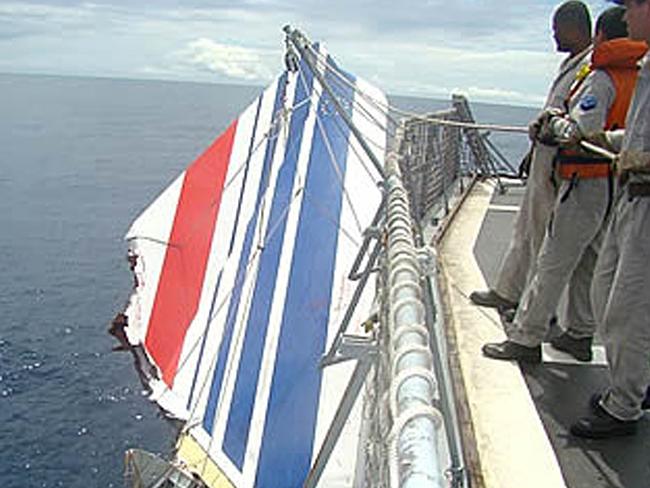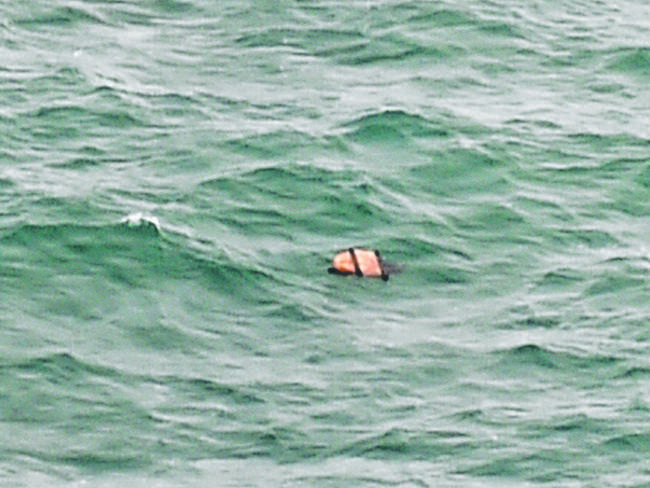Knowing 5 QZ8501 Crash Scenarios Ahead Of The Black Box Recovery
Air crash experts and aviation analysts weigh in on what could have happened in the ill-fated flight's final moments.
1. Emergency sea landing: The plane may have successfully landed on the water without any destructive impact, only to be overcome by high seas in the stormy weather
US Airways Flight 1549 in the Hudson River, New York, USA on 15 January 2009.
Image via chicagotribune.comThe Airbus A320-200 left the Indonesian city of Surabaya early Sunday and disappeared from radar over the Java Sea during a storm, but it failed to send the transmissions normally emitted when a plane crashes or is submerged. Experts say this suggests the experienced former air force pilot, Captain Iriyanto, conducted an emergency water landing which did not have a destructive impact.
"The emergency locator transmitter (ELT) would work on impact, be that land, sea or the sides of a mountain, and my analysis is it didn't work because there was no major impact during landing," said Dudi Sudibyo, a senior editor of aviation magazine Angkasa.
An emergency exit door and an inflatable slide were among the first items recovered by the search team, suggesting the first passengers may have started the evacuation process once the plane landed on water. Passengers may have been waiting for a flight attendant to inflate a life raft when a high wave hit the nose and sank the plane.
However, aviation expert Oliver Lamb pointed out that landing a plane smoothly on water is "extremely difficult" even when the seas are calm, let alone during a storm
"Landing an aircraft on water is extremely difficult and extremely rare,” the managing director of Ailevon Pacific Aviation Consulting told News Corp Australia. “In order to successfully land on the water, you need to have very calm seas, a very skilled pilot and you need to be in an area where all the technical conditions and atmospherics are easily managed. Otherwise, it’s like hitting concrete.”
As for the transmission signals not being made, Mr Lamb said there were other explanations, such as: “the transmission could have been made but wasn’t picked up, or it was made but couldn’t get through.”
2. Thunderstorm factory: Veteran pilots reportedly avoid the area where the plane vanished because of its violent weather patterns.
Data from Indonesia's meteorological agency showed slight rain in the Belitung and Pontianak areas when the plane was estimated to be flying through the vicinity, with thick cumulonimbus clouds as high as 45,000 feet.
Such clouds can produce lightning and other dangerous weather conditions, such as gusts, hail and occasional tornadoes.
Mark D. Martin, founder and CEO of Martin Consulting, said: "In the unfortunate event of entering a cumulonimbus cloud at flight levels between 31,000 feet and 38,000 feet, it is common to see heavy updrafts and downdrafts, icing on control surfaces which can freeze corrective pilot actions, aggressive aircraft manoeuvres and the aircraft dramatically lose altitude in excess of 5,000 feet per minute."
Aviation expert Neil Hansford claimed someone “dropped the ball” when plotting the aircraft’s course. "You plan to go around it. You don't plan to go through it," he said.
While the storms may have caused the plane to experience severe turbulence, it is unlikely for the plane have broken apart mid-flight, as planes were designed to withstand serious structural damage by lightning or storm
CNN correspondent Tom Foreman said in a video that it was unlikely for the A320 jet carrying 162 on board to be brought down by lightning or for a storm to break the plane apart mid-flight, pointing out that such planes were designed to withstand lightning and tremendous pressures.
3. Mid-air stall: A technical malfunction caused the pilot to accidentally induce an aerodynamic stall mid-air, not unlike the disaster that caused the Air France 447 crash in 2009 when it tried to avoid a thunderstorm
The Air France crash over the Atlantic is believed to have been caused when an airspeed measurement tool called pitot tubes froze – causing the pilot to believe they were travelling significantly faster than they actually were.
Some experts have said the aircraft might have experienced an aerodynamic stall because of a lack of speed or from flying at too sharp an angle to get enough lift.
Analysts have also said that the pilots might not have been getting information from onboard systems about the plane's position or that rain or hail from thunderstorms in the area could have damaged the engines.
While it is technically possible, the stall could only occur if the plane was travelling too slowly. Some have also pointed out that a well-trained pilot would have been able to correctly estimate the plane's speed in broad daylight.
“A midair stall is when a plane is travelling too slowly in the air for it to remain upright,” Lamb said. “It shouldn’t happen, because the pilot should know what the minimum speed is at that height. Pilots are well-trained at the event of a stall, and the AirAsia pilot was travelling at a high enough altitude to be able to recover if there was a stall.”
Other experts point out that the Air France flight was travelling at night – meaning the pilot was unable to see the horizon and estimate his speed – whereas the AirAsia aircraft came down during Sunday morning so the pilot would have been able to see the sun and track his speed, correcting any error before it became fatal.
4. Plane broke apart upon impact with water: Judging by the "contained" debris and intact bodies that had been found, the plane was still in one piece when it hit the ocean
Indonesian Air Force personnel on Tuesday, December 30, show debris, including a suitcase, that was found floating near the site where AirAsia Flight QZ8501 disappeared on Sunday.
Image via CNN"The fact that the debris appears fairly contained suggests the aircraft broke up when it hit the water, rather than in the air," Neil Hansford, a former pilot and chairman of consultancy firm Strategic Aviation Solutions said.
Retired United States airline pilot John Cox, who runs his own consultancy, said: "I am now seeing doors and reports of a large section located on the sea floor which are indicators, but not conclusive evidence, that the plane was in one piece when it hit the ocean.
"If the wingtips, nose and tail are found in the same area, then it will be conclusive that the plane was intact upon impact with the water."
The close proximity of the debris field to its last known location (about 10km away) suggested that the aircraft plunged almost vertically into the water
The plane behaved in ways ‘bordering on the edge of logic,’ Indonesian aviation analyst Gerry Soejatman said after examining figures leaked from the official air crash investigation team.
Soejatman said the jet climbed at a speed that would have been impossible for the pilot to have achieved - and then plunged straight down "like a piece of metal being thrown down".
Australian aviation expert, Peter Marosszeky, from the University of NSW, said he was baffled by the extremely low speed of the descent - as low as 61 knots - which would suggest the plane was heading almost straight down, explaining why it has been found in water just 10km from its last point of radar contact.
5. Plane crashed in less than 45 seconds: The pilot could've lost control in a thunderstorm, causing the plane to dive into the water from 32,000 feet in a very short amount of time
CNN correspondent Tom Foreman likened the scenario to aquaplaning, in which a car travelling at speed on a wet road loses control when it hits a body of water and skids.
“Did it run into such severe changes in atmosphere pressure that at one moment, it was surging forward, next moment, it was being yanked back and it suffered a separation from the air flow?” he questioned. “If an experienced pilot is not at the helm to do a very good job, even an experienced pilot may have trouble, that pilot may have a hard time getting that control back, and in that circumstance, a plane like this could go from 32,000 feet to in the water in maybe 45 seconds or less."
None of the recovered victims were wearing jackets, further giving weight to the theory. The plane's passengers were probably aware of the plane's sharp descent, but did not have enough time to react.
Analysts reviewing the course and location of Flight QZ8501 suggested the pilot ascended sharply to avoid a storm but the manoeuvre failed, possibly because the weather damaged the plane’s instruments. This would have caused the plane to shake fiercely before its nose pitched forward – and passengers would most likely have known that the plane was dropping.
telegraph.co.ukInvestigators have already begun to start piecing together the final moments of Flight QZ8501 with available wreckage, although we will never truly know of the events leading to the plane's crash until the black boxes are recovered
The key to understanding what happened is likely to be contained in the aircraft's cockpit voice recorder and flight data recorder, commonly known as black boxes.
"Until we get the black boxes, we won't know what's going on with the engines," Bill Savage, a former pilot with 30 years of experience, told CNN.





